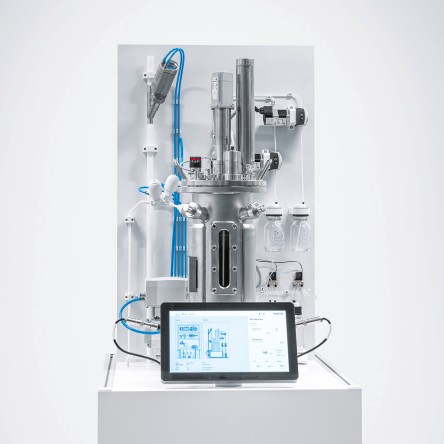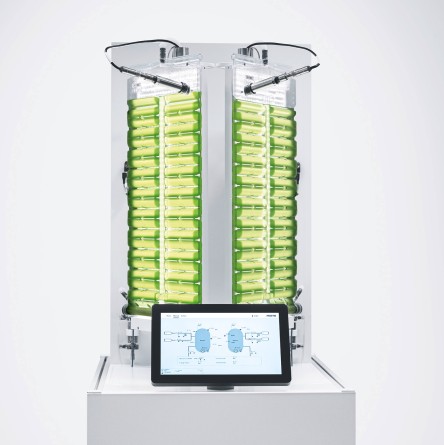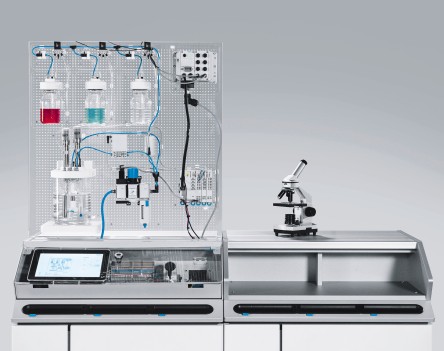Optimized conditions for the cultivation of microorganisms
In order for microorganisms such as bacteria, algae and yeasts to grow ideally and to achieve a high biomass, ambient conditions must be created in the reactor that are precisely tailored to their needs. This requires the measurement, recording and control of many variables.
In addition to the temperature and pH value, the nutrient supply and precise gassing of air, oxygen and other gases play a central role. Festo provides components and solutions from the fields of gas handling, liquid handling and control technology as well as solutions up to the ready-to-install control cabinet.

Bioreactor:
Highlight products and their function
Here, we are showing a stainless steel bioreactor that is frequently used in industrial biotechnology.
Gas handling: precise flow control
The VEMD mass flow controllers are used to dose the gases. In addition to air, nitrogen, CO2 and oxygen in particular are used.
Liquid handling: precise dosing through overpressure
The pressure-over-liquid method is used to dose the liquid media in the reactor via the proportional pressure control valve VEAB. The valve is used to apply pre-pressure to a media container. The medium enters the reactor due to the overpressure.
The media separated solenoid valve VYKA controls even the smallest quantities with high precision and is also suitable for aggressive substances such as alkalis, acids and other chemicals.
The FDA-compliant VZBD ball valve, which is adjusted by the DFPD semi-rotary drive and the CMSX positioner, is used to control the temperature of the reactor.
Control: automated control of all parameters
The CPX-E controller controls the components in the reactor, thereby automatically regulating the pH value, temperature and other factors that influence the growth of the microorganisms. Connection to a control system using the MTP standard is possible.
The CDPX operating screen displays the appropriate dashboard for operating the bioreactor via touchscreen.

Algae reactor:
Highlight products and their function
Photosynthesis is a central metabolic pathway for the growth of algae. CO2 is converted into sugar and oxygen is released. The two 6 litre flat-panel airlift photobioreactors (FPA) from Subitec enable the productive cultivation of microalgae through the optimal use of light, CO2 and nutrients.
Gas handling: two concepts for gassing
The application shows two ways of controlled gassing: on the one hand, exactly the right amount of air and CO2 is fed into the reactor using a VEMD mass flow controller.
On the other hand, gassing is controlled with the VEAA pressure regulator in conjunction with the SFAH flow sensor. This measures the actual amount of CO2 and air.
Liquid handling: food-safe valve technology
The pneumatically driven food-safe pinch valve VZQA is used for filling and emptying the reactor or for sampling.
Control: Product innovation in use
These valves are controlled by the new VTUX valve terminal. The CPX-E controls and regulates the components in the reactor, thereby automatically regulating the pH value, temperature, gassing and light.
Always the right solution
In addition to individual components, Festo also offers customized system solutions for bioreactors. Customized automation solutions are developed from selected components, for example in the form of complete control cabinets. Customer-specific software can also be created, from the control system to the cloud. Seamless integration of the systems and the ability to analyze data in real time enable efficient and transparent process control.
Biologization as a learning field
Festo is not only meeting the new challenges in the field of biologization from a technical perspective, but as a market leader in basic and further training, it is also keeping an eye on the qualifications required in the future.
In the area of its own vocational training, Festo has therefore launched the additional qualification "Climate protection and sustainable development" together with the Stuttgart Region Chamber of Industry and Commerce. It is aimed at a number of training professions. There will be an "Automation of Biological Transformation" module for industrial-technical and commercial trainees in particular.
Festo will cover parts of this in its training center and will begin with its own trainees. Festo is also developing a modular training concept for prospective biomechatronics engineers, which can be used to impart knowledge, especially technical basics.
There are also concrete plans for higher education. We are currently working with Reutlingen University to design a new biomechatronics degree program that combines biological and technical content with a focus on the cell as the world's smallest factory. The new learning reactor will also be used here.
Learning reactor: modular system for biomechatronics engineers
In addition to the development of new job profiles, Festo has designed a modular training concept for prospective biomechatronics engineers that can be used to impart knowledge, especially the technical fundamentals. The system consists of learning software and various learning hardware housed in a modular carrier system.

Learning software: the learning software is a prototype based on the proven Festo LX learning platform, which conveys the content in a playful way and prepares learners for the tasks.
Learning hardware: the supplementary hardware consists of a bioreactor for cultivating yeasts and applications for sampling. The system also incorporates two Festo Didactic products: the control cabinet of the SkillsConveyor, which is already available, and the electeo training system, which will be presented for the first time at Hannover Messe.
Support system: the training system consists of five modules and can be expanded and combined with other modules as required. The angled shape of the integrated elements enables ergonomic learning.